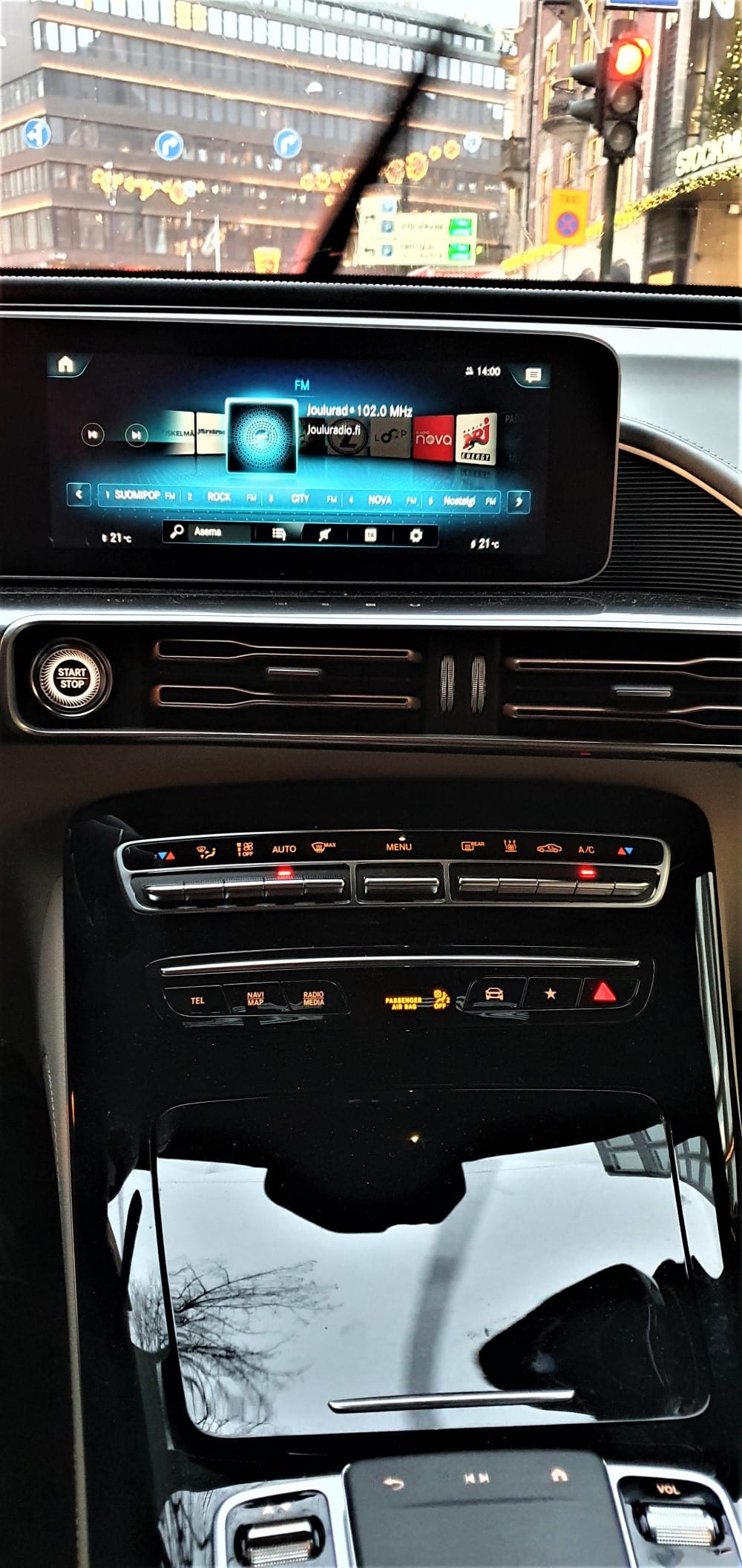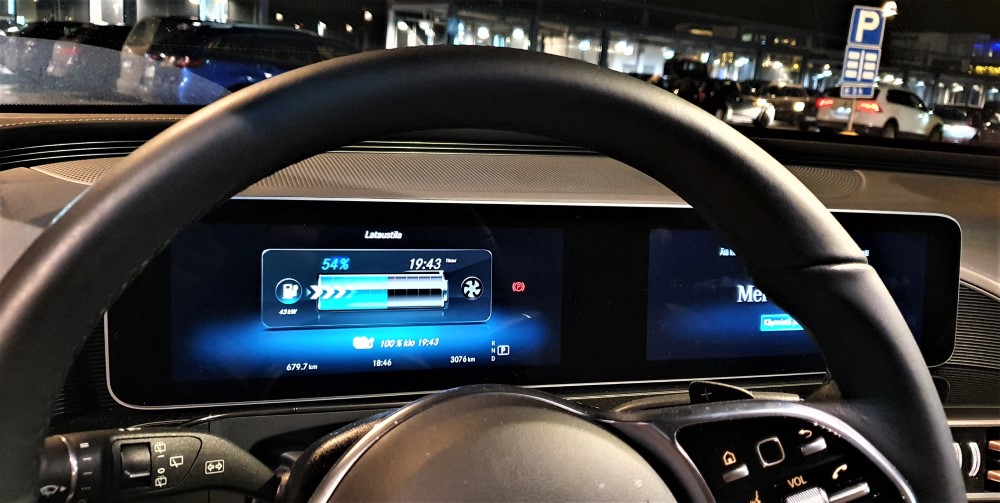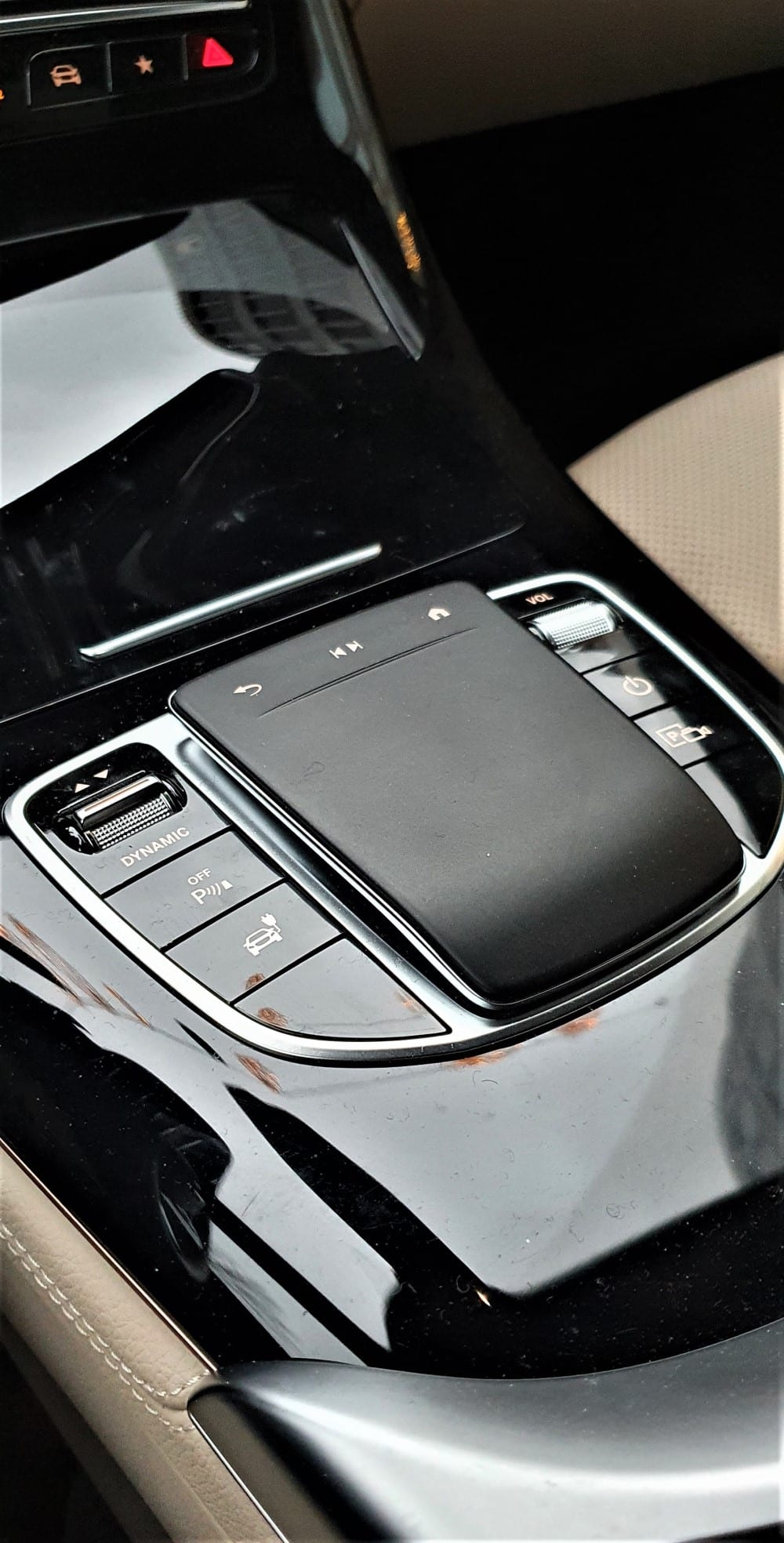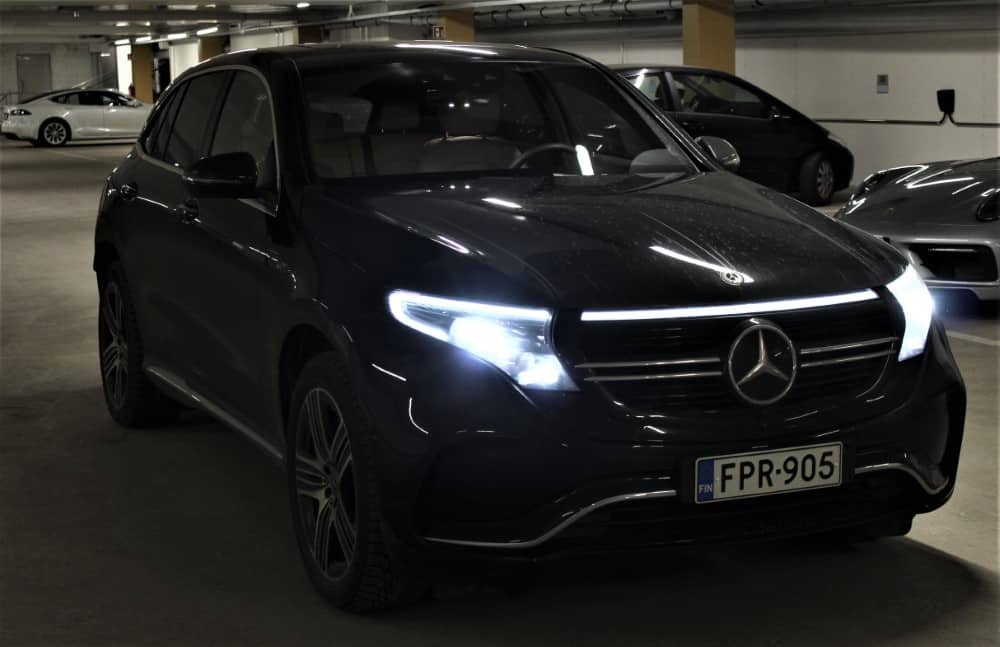First, let’s get the facts straight: the Mercedes-Benz EQC is a stunning feat of engineering by one of the legendary car makers to meet the challenge of electrification in motoring.
Then the second: used with the carefree attitude of an internal combustion engine car, the same car is so power-hungry that instead of enjoying the drive, you’re left gazing at the dwindling mileage in your eyes.

If one had the courage to follow the importer’s instructions and the planning required for electric cars, the situation would probably be different.
I have to admit that there is no warning; in cold weather, the battery and, if possible, the cabin must be preheated before use, or all the energy will be sucked out of the traction battery. If you ignore these instructions, you will literally notice it on the road. And for cold weather, normal autumn weather in southern Finland, i.e. a few degrees Celsius, is sufficient; no actual frost is needed.
Both the EQC’s battery and the interior are heated by their own seven-kilowatt resistor, which is easily enough to warm them both up quickly. The importer also pointed out that the air conditioning heating resistor is more efficient than the heater, meaning it actually needs its power.
Battery pre-heat can be conveniently turned on from the EQ menu, or from the me app. It really pays to do this, otherwise the convenience and strengths of the EQC will be lost in the lurking of the next charging station.
Compared to internal combustion engines, electric motors don’t generate waste heat to heat the cabin, but other solutions have had to be found; not everyone has a warm starting garage, and you can’t always oblige passengers to wear polar jackets.

Elegance in action
The first MB EQCs rolled out of Mercedes’ Bremen plant back in 2019, and since then a few other plants have gotten up to speed. The EQC is essentially a medium-sized electric car, although it also weighs around 2,500 kilograms, of which the battery pack accounts for 652 kilograms. As an option, the car also comes with a tow hook to pull a braked trolley weighing up to 1,800 kilos.
EQ stands for “Electric Intelligence”, derived from MB’s “Emotion” and “Intelligence”. Emotion is a matter of taste, but yes, MB’s elegance is still going strong.
The EQC has intelligence to share, and not everything is “hidden” in one big touchscreen – someone likes a mother, someone likes a daughter. So for someone used to the button wizardry of an internal combustion engine car, the transition to the EQC is a low threshold.
Power is transmitted to the four drive wheels and both axles by two asynchronous engines, the front with 148 kW and the rear with 162 kW. The front engine accelerates linearly and the rear engine is more responsive.
The EQC has a combined output of 300 kilowatts, or 408 horsepower, and 750 newton metres of torque. The torque is dynamically distributed between the front and rear axles, striking a balance between power and economy.
On this basis, the car is promised a zero to 60 mph acceleration of 5.1 seconds. With 500 litres of space in the boot with passengers and 1,460 litres with the back seat folded down, the battery pack under the floor between the axles does not take up excessive transport capacity.
And the most important thing about the electric car: the EQC has a battery capacity of 80 kilowatt-hours, which should give it a minimum range of 374 and a maximum range of 417 kilometres, depending on the equipment. The combined energy consumption of the EQC over 100 km is claimed by the manufacturer to be between 22.3 and 25 kWh.
In late December, at temperatures hovering around zero, the EQC consumed between 22 and 30 kWh per 100 km, depending on the weight of the accelerator pedal, at the winter speed limits of 80-100 km/h on the five-lane road, and even more than 30 kWh on the motorway without trying harder. However, the significant consumption does not come as a surprise to the driver, as the EQC reports imminent roadside incidents with scrupulous accuracy.

Sneaks up like a cat
The first thing that draws attention to the EQC’s controls is the wide, horizontal display panel, which reports on the state of the car and surrounding conditions, and also allows the user to express their own views on how they want the car to perform in a given situation.
The second initial observation relates to the sounds and, more specifically, the lack of them. The car is exceptionally quiet and moves like a lynx stalking on a slope. This has been achieved by, among other things, isolating the battery packs from their housings and the car body with rubber inserts and numerous other damping solutions. The EQC continues its silent creep beyond the 13,000 rpm limit, which is considered the critical limit for electric motor loudness.
Everything in the cabin is clear and finished, with a harmonious colour scheme and controls within easy reach of the driver. The driver and three passengers of typical Finnish size can comfortably find a travel position that suits them.
In terms of interior space, controls, feel and chassis, the EQC is, in a word, elegant; it is a businesslike, even ethereal, gentleman’s, or perhaps lady’s, vehicle.
On the road, the EQC moves along smoothly, with a soft suspension and almost silently, like a big cat. Even in about six inches of snow, its performance on the test car’s friction tyres was effortless and scrupulous.
Much of the darkest season’s test driving took place at dusk, or in total darkness, but thanks to the EQC’s standard glare-free high beam assist and excellent light output, darkness was the least of the challenges.

Charging is critical
Then a bit about the EQC’s battery solution and its capabilities.
Behind the wheel of the car, there are gear levers that allow you to adjust the amount of energy the battery can draw while driving. If you select ‘D Auto’ mode and ‘Max Range’, the EQC optimises its own energy consumption according to the situation, making use of the ECO Assist function. Energy is generated by an 80 kWh lithium-ion battery placed under the floor and between the axles, which supplies power to both electric motors.
In total, the battery has 384 cells in six modules, of which two have 48 and four have 72 cells. With this configuration, the battery has a nominal voltage of about 350 volts and a capacity of about 218 ampere-hours, giving an energy production capacity of 80 kilowatt-hours.
According to the manufacturer, the battery charges at a maximum of 110 kilowatts when charged with direct current, which is a standard feature of the EQC. In practice, this allows the battery to be charged in around 40 minutes up to 80 percent charge.
However, this is not particularly high when compared to the best competitors: if the battery is suitably warm, charge rates can be as high as 200-300 kilowatt-hours with a powerful charger. And a cold battery will not be able to receive even 100 kilowatts of power, even with a charger.
Like the Tesla, the EQC has a charging hatch in the rear fender, so you practically always have to approach the charging point rear-first. Most of the time the position of the hatch is not a major issue, but sometimes in tight side-by-side parking of several electric cars, front-end parking might be easier.
For standard home charging, the importer recommends getting a two-phase wall charging station, which takes 11 hours to reach 80% charge, three times faster than a typical household outlet. The car comes standard with a 7.4 kilowatt OBC charger for charging from AC outlets typically used at home, and a CCS DC charger for use in Europe and the US. The best ones are currently capable of 11 kilowatts of charging from an AC charger typically used at home, and the Tesla X’s AC charger, for example, charges at 16.5 kilowatts.

EQC’s intelligence is worth exploiting
It’s worth setting the next planned fast charging station in the car’s navigation system, as EQC takes this into account by warming up the battery to the right temperature to receive the maximum charging power. In this way, the promised charging power would also appear to be achievable in practice.
The three factors that have the greatest impact on the operating range of an electric vehicle are driving style, driving style and driving mode, and in particular driving speed. For this, the EQC offers the driver five alternative driving programmes: Comfort, Eco, Max Range, Sport and Individual, i.e. a customisable programme.
It is often wondered why powerful electric cars drive at the maximum permitted speed while internal combustion engine cars consume the left lane at the same time. In the case of the EQC, the answer may be the Eco setting, which indicates the maximum speed at which the car can reach the next charging point, or other desired destination.
With EQC, the accelerator pedal gives the driver proactive energy-saving tips, for example when approaching a lower speed limit, and a special scrolling function is also available.
The EQC’s promised intelligence monitors navigation data, recognises road signs, uses radar and a stereo camera, and combines this information to minimise electricity consumption.
In addition, the electric motors are capable of acting as both traction motors and energy harvesting motors, regardless of their direction of rotation. In practice, both motor braking and pedal braking convert mechanical rotational motion into electrical energy to charge a high-voltage battery. With maximum energy recovery, the maximum deceleration of the EQC is 0.25 g.

Not easy for an electric car driver
Antti Järveläinen, a wise colleague and test driver of many electric cars, gave me some advance guidance:
If you are considering an electric car, the three most important reasons are:
- The available capacity of the battery
- Charging speeds with DC and AC chargers
- Electricity consumption while driving
Although the Finnish charging network is likely to grow significantly already this year, there are very few efficient CCS chargers of more than 100 kW available. There are already a few more CCS chargers of less than 50 kilowatts, especially in K and Lidl stores.
After that, the charger scene is much wilder, with the arrival of 22 kilowatt Type 2 inverters. These are typically found in large shopping centres and some public charging points, and the power of the car’s internal charger determines how quickly the electric vehicle can receive the power they supply. With Type 2 chargers, the extra power is only available for less than 50 kilometres per charging hour, so patience is required.
If only the chargers could be trusted. I tried to charge the EQC from the only Virra charger in Katajanokka, Helsinki.
“Hello! I have now sent three text messages to the number on the charging label and each time I have received the reply: Mobile number not recognized. However, everything should be correct.”
“Yes, SMS charging has not been used for several months now. Some poles still have stickers on them.”
“Then how can I pay for the download and get the download shutter open?”
“You have to log in to the mobile app and enter your credit card details”.
“Ok, I’ll do it right here on the street”.
“Okay, the hatch is open. I’ll plug in the wires now. Charging won’t start.”
“Ok, I’m turning on remote charging”. A minute, another, another, another.
“Charging will not start. Unplug the pole and I’ll turn the pole back on”.
“The pole cover won’t open, I can’t unplug the plug”.
“Ok, unplug the cable from the car.”
“Now the cable is off the car”.
“Ok, I’m turning the pole back on. The red light should flash. Then the hatch will open.”
A minute goes by, another, third, fourth.
“The cover won’t open. I can’t stay all night waiting for it to open. Can I tear open the pole cover and go looking for a working pole?”
“Okay, I’ll order a service for that. Where can I send the cable?”
“What the hell? I can’t leave the cable attached to this pole because I need it to charge the car from another pole”.
“Ok, I’ll try the pole again”.
Suddenly the pole cover pops open and the other end of the cable can be disconnected.
“Now I’ve got the cable with me. After this, it won’t be long before I’m not charging the car from your pole”.
“Sorry. You can charge next time free of charge as compensation for this experience”.
The Mercedes-Benz EQC is in many respects an excellent and well-finished car, and you feel so comfortable behind the wheel that you don’t really miss the advent of autonomous cars.
If the car needs to be used for long journeys overland, the electric car driver and the EQC driver in particular need to be careful and plan the route in advance. And sometimes even that is not enough if the planned charging points are out of order, or unavailable, and the car is too risky to continue the journey.

Fully electric cars are set to break into the market possibly this year
In Finland too, partly driven by incentives from the current government. If you expect carefree motoring and your driving needs are mainly on the road, a hybrid car is still a safer choice for now.
If you can charge your car at home and your driving needs are mainly less than 200 km per day in summer and winter, a full electric car is already a strong option.

Mercedes-Benz EQC 400 4Matic Edition AMG
- Engine: two asynchronous electric motors
- Front motor power: 148 kW.
- Rear engine power: 162 kW.
- Total maximum power: 300 kW, 408 hp.
- Total maximum torque: 750 Nm.
- Driving battery capacity: 80 kWh
- Acceleration: 5.1 sec (0-100 km/h)
- Energy consumption (WLTP) 22.3-25.0 kWh/100 km
- CO₂ emissions: 0 g/km.
- Curb weight: 2495 kg.
- Traction: four-wheel drive
- Boot space: 500 l.
- Towing capacity: 1800 kg.
- Starting price: €79 371 (400 4Matic Edition AMG)
- Starting price for the test drive: €90 239





